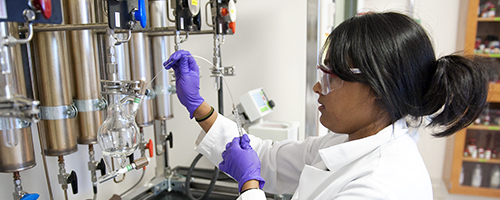Document Type
Article
Publication Date
1-1-1985
Publication Title
Journal of Biological Chemistry
Abstract
The reduction of cytochrome c oxidase by dithionite was reinvestigated with a flow-flash technique and with varied enzyme preparations. Since cytochrome a3 may be defined as the heme in oxidase which can form a photolabile CO adduct in the reduced state, it is possible to follow the time course of cytochrome a3 reduction by monitoring the onset of photosensitivity. The onset of photosensitivity and the overall rate of heme reduction were compared for Yonetani and Hartzell-Beinert preparations of cytochrome c oxidase and for the enzyme isolated from blue marlin and hammer-head shark. For all of these preparations the faster phase of heme reduction, which is dithionite concentration-dependent, is almost completed when the fraction of photosensitive material is still small. We conclude that cytochrome a3 in the resting enzyme is consistently reduced by an intramolecular electron transfer mechanism. To determine if this is true also for the pulsed enzyme, we examined the time course of dithionite reduction of the peroxide complex of the pulsed enzyme. It has been previously shown that pulsed cytochrome c oxidase can interact with H2O2 and form a stable room temperature peroxide adduct (Bickar, D., Bonaventura, J., and Bonaventura, C. (1982) Biochemistry 21, 2661-2666). Rather complex kinetics of heme reduction are observed when dithionite is added to enzyme preparations that contain H2O2. The time courses observed provide unequivocal evidence that H2O2 can, under these conditions, be used by cytochrome c oxidase as an electron acceptor. Experiments carried out in the presence of CO show that a direct dithionite reduction of cytochrome a3 in the peroxide complex of the pulsed enzyme does not occur.
Volume
260
Issue
12
First Page
7165
Last Page
7167
ISSN
00219258
Creative Commons License

This work is licensed under a Creative Commons Attribution 4.0 International License.
Version
Version of Record
Recommended Citation
Brunori, M.; Bickar, D.; Bonaventura, J.; and Bonaventura, C., "Kinetics of Reduction of Cytochrome c Oxidase by Dithionite and the Effect of Hydrogen Peroxide" (1985). Chemistry: Faculty Publications, Smith College, Northampton, MA.
https://scholarworks.smith.edu/chm_facpubs/86


